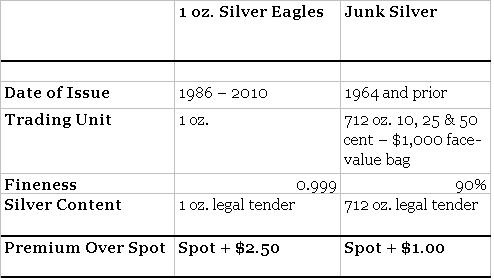
Better Value: Mint Silver Coins Versus “Junk” Silver Coins
“‘Ain’t it purty’ is not a good reason to buy.”
When the U.S. Mint launched the Silver Eagle, their marketers knew exactly which buttons to push to excite collectors/investors.
It’s no wonder that when it launched the Silver Eagle, the Mint copied the A. A. Weinman design for the Walking Liberty half dollar. Millions of those coins were minted between 1916 and 1947 and are still prized by collectors to this day.
It’s no surprise, therefore, that the one-ounce Silver Eagle was an immediate success. It quickly grabbed a large percentage of the legal tender silver coin market from the one-ounce Canadian Maple Leaf and the Australian Kookaburro.
But the success of the Eagle is another example of emotion overruling good investment judgment.
To understand why, let’s compare the one-ounce Silver Eagle to the top contender for the silver heavyweight championship – our old standby, the 90% silver coins that Uncle Sam minted until 1965. These dimes, quarters and half-dollars are known affectionately as “junk” silver. But there’s nothing “junk” about them.
The standard trading unit for “junk” silver is a bag of such coins with a $1,000 face value. Each bag contains 712 ounces of .999 silver. And as the price of silver has increased, so has the price of a bag.
With silver at $18 per ounce, a bag now retails for about $14,000.
This may be more than you wish to spend. Therefore, Asset Strategies International offers smaller quantities, too. You can purchase $100 face-value bags, which contain 71.2 ounces of silver. The premiums for these smaller quantities will be a bit higher, but they’re still less than the premiums for Silver Eagles. The following chart shows the comparison between the two…

Why This “Junk” Can Be Your Treasure
We consider both silver Eagles and “junk” silver as perfect “core holdings” for your precious metals portfolio. They both satisfy the criteria of being well-recognized and are legal tender.
Where they differ dramatically is the cost per ounce of the premium. For silver Eagles, it is common to see a premium of $2.50 per ounce or more. On the other hand, “junk” silver current sells for spot, plus a premium of approximately $1 per ounce. The premium can fluctuate depending on supply and demand, just like the spot price of silver.
So given a choice, which should you purchase for physical possession – silver Eagles or “junk” silver?
It’s clear to me that “junk” silver is the better buy, by as much as $1.50 per ounce.
It’s our job to teach our children and grandchildren the lessons we’ve learned. A $100 bag of “junk” silver would be a great way to start. In fact, I recommend that every family own at least one $1,000 face-value bag of “junk” silver, plus a $100 bag for each child.
What better way to pass on your appreciation of “real money” to the next generation? The coins are pretty to look at, lovely to hold and make a marvelous ringing sound when dropped on a table.
And by the time your children have children of their own, they’re likely to have grown substantially in value, too.
Glen O. Kirsch
Asset Strategies International
P.S. For more information about “junk” silver, please send us an e-mail, or call us at: 800.831.0007. We’ll be happy to answer any questions you may have and have also prepared a “junk” silver fact sheet with more details.sus “Junk”
When the U.S. Mint launched the Silver Eagle, their marketers knew exactly which buttons to push to excite collectors/investors.
It’s no wonder that when it launched the Silver Eagle, the Mint copied the A. A. Weinman design for the Walking Liberty half dollar. Millions of those coins were minted between 1916 and 1947 and are still prized by collectors to this day.
It’s no surprise, therefore, that the one-ounce Silver Eagle was an immediate success. It quickly grabbed a large percentage of the legal tender silver coin market from the one-ounce Canadian Maple Leaf and the Australian Kookaburro.
But the success of the Eagle is another example of emotion overruling good investment judgment.
To understand why, let’s compare the one-ounce Silver Eagle to the top contender for the silver heavyweight championship – our old standby, the 90% silver coins that Uncle Sam minted until 1965. These dimes, quarters and half-dollars are known affectionately as “junk” silver. But there’s nothing “junk” about them.
The standard trading unit for “junk” silver is a bag of such coins with a $1,000 face value. Each bag contains 712 ounces of .999 silver. And as the price of silver has increased, so has the price of a bag.
With silver at $18 per ounce, a bag now retails for about $14,000.
This may be more than you wish to spend. Therefore, Asset Strategies International offers smaller quantities, too. You can purchase $100 face-value bags, which contain 71.2 ounces of silver. The premiums for these smaller quantities will be a bit higher, but they’re still less than the premiums for Silver Eagles. The following chart shows the comparison between the two…
